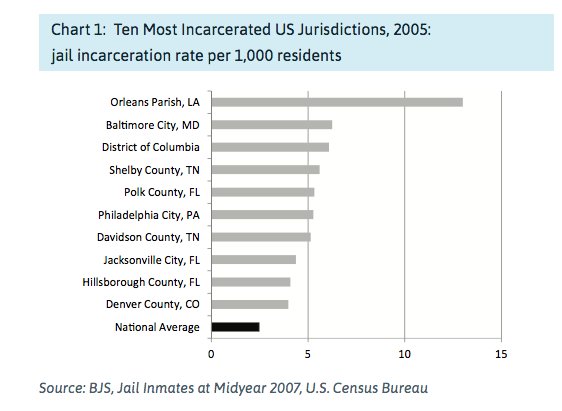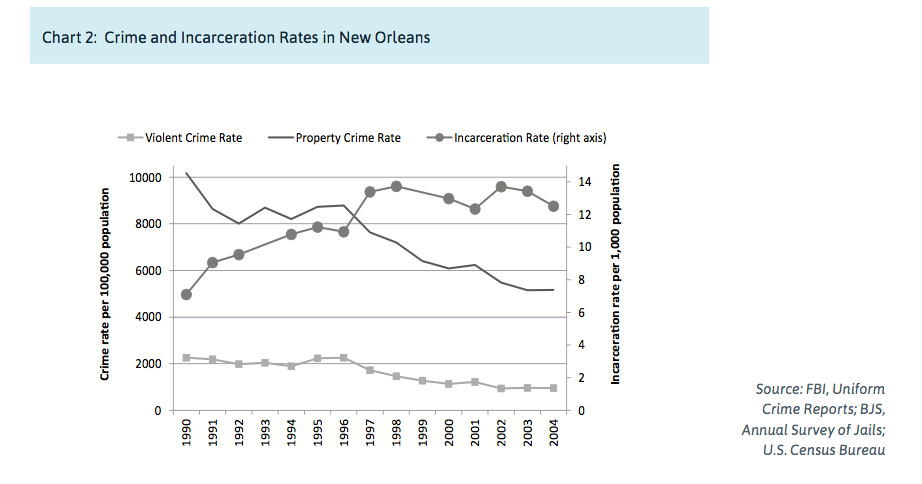How New Orleans Has Brilliantly Reduced its Jail Population

By:
As attention shifts to systemic problems with mass incarceration in America -- problems with bail, solitary confinement, drug sentencing, private prisons, the racial inequity of those who are incarcerated -- a new report was just released about incarceration in New Orleans.
A decade ago, "New Orleans’ local incarceration rate was more than five times the national average," states the report from the Data Center, a Louisiana-based research organization. After Hurricane Katrina in 2005, the city began to focus on criminal justice reform as it was clear that mass incarceration was unsustainable. This stark reality was apparent when many prisoners were abandoned during the storm.
Over the last ten years, though, New Orleans has reduced its incarceration rates in local jails by 67 percent.
 The Data Center - amazonaws.com
The Data Center - amazonaws.com
Why was the rate of incarceration so high in New Orleans?
The state of Louisiana as a whole has been named the incarceration capitol of the world. A 2012 article from the New Orleans Times-Picayune reported that one in 86 adults was behind bars, and one in 14 Black men from New Orleans was behind bars. (And the report goes into detail about the ways profit is made off of incarceration.)
For those pointing to New Orleans' previous designation as the "murder capitol of the U.S.A." as a reason for high rates of incarceration, it's important to note that this report dealt with local jails -- not prison. As ATTN: has discussed before, there is a difference between jails and prisons . Jails often house those who have been arrested and are awaiting trial. Some of those held in jail have been deemed too dangerous to the public or too likely flee the jurisdiction to be granted bail. Increasingly, however, those in jail are poor people who could not afford to pay bail.
From the chart above, you can see that in 2005, New Orleans outpaced many cities in the number of inmates in local jails. In 1981, the local jail held 2,300 inmates. Before Katrina in 2005, the jail housed 6,300. The Data Center lists several, major reasons for high incarceration rates in the local jail.
Inability to pay bail was one of the reasons for New Orleans' outrageously large inmate population at its local jail, Orleans Parish Prison (OPP) (OPP is mislabeled as a prison -- it's actually a jail), the Data Center reports. From the report:
"There was no mechanism to assess defendants’ risk; judges set a bail amount based on the arrest charges and what was known of the criminal history and defendants either paid their way out or remained detained.In the regular court process, magistrates released virtually no defendants on their own recognizance or on an unsecured personal surety bond, that is, without an upfront, nonrefundable payment. In many other U.S. jurisdictions, it is common for nonfinancial release to be used for half or more defendants, especially those charged with nonviolent offenses."
Another major issue in New Orleans? Locking up those arrested for nonviolent crimes. Between 2003 and 2004, (just a few years before the storm) 86 percent of arrests came on nonviolent charges. The local New Orleans jail was also being used not just for pretrial detention, but also for locking up people serving several year sentences.
Another important takeaway from these jail numbers was that there was no correlation found between the high rates of incarceration and an improvement of public safety, the report found.
 The Data Center - amazonaws.com
The Data Center - amazonaws.com
The report also mentioned a skewed incentive system: the OPP jail had morphed into a profit center for local government. The Data Center explains:
"The city’s incarceration practices also impacted the broader community financially, as taxpayers paid for jail operations through the city’s general fund. Indeed, the city paid the Sheriff a per diem for each inmate. By foregoing its budgeting authority for the jail, the city had relinquished all responsibility to the Sheriff and incentivized the Sheriff to house as many people as possible. The cost to the city of operating the jail more than doubled between 1990 and 2004, from $15 to $35 million annually. The increased number of inmates and ineffective management led to OPP becoming dangerous and unhealthy for inmates and staff alike."
The Times-Picayune piece shows that in much of rural Louisiana, sheriff budgets are tightly wound with incarceration levels.
"[M] ost prison entrepreneurs are rural sheriffs, who hold tremendous sway in remote parishes like Madison, Avoyelles , East Carroll and Concordia," the paper reported in 2012. "A good portion of Louisiana law enforcement is financed with dollars legally skimmed off the top of prison operations."
The report also found that the New Orleans court system was collecting fees in a similar manner as the government in Ferguson, Missouri, a manner that the U.S. Department of Justice stated “violate[s] the 14th Amendment’s due process and equal protection requirements [,] … impose[s] unnecessary harm, overwhelmingly on African-American individuals, and run[s] counter to public safety.”
How did New Orleans reduce its local jail population?
Following the devastating hurricane, New Orleans was faced with not only terrifying images of how the prison population was treated post-storm, but it was also faced with two realities, according to the report. " First, the system was failing at addressing violent crime," the Data Center states. " And second , the system’s focus on incarceration had devastating effects on communities."
In 2010, a new jail complex was proposed, initially planned to have 5,832 beds. Through community activism, the 2011 plans reduced the facility to 1,438 beds. The New Orleans government had no choice but to reduce the jail population.
With the help of the Vera Institute, the local government made two major changes: it stopped arresting those with nonviolent municipal charges like marijuana possession; instead they issued a summons and trusted that the defendant would appear in court.
"Prior to this initiative, officers were arresting 70 percent of people charged with nonviolent municipal offenses," the report found. "After the initiative, and consistently since then, the rates have reversed, with officers issuing summonses in 70 percent of those cases."
There was also reform in the bail system -- including setting better guides for judges to determine if a person should be in jail prior to their trial based on risk of re-offending and flight risk. In 2012, the report states, the New Orleans Pretrial Services opened.
Overall, the daily jail population went from 6,000 prior to Katrina to 1,900 in April of 2015. There is still more work to do, however. New Orleans is just one city in Louisiana, a state that faces huge problems with mass incarceration.
